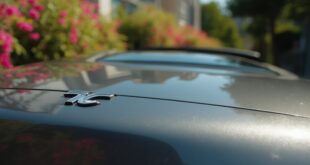To change brake pads with an electric parking brake, start by connecting a car battery charger and using a diagnostic tool to stabilize voltage. Then, release the parking brake pistons with the diagnostic scanner. Remove the caliper and push back the pistons, ensuring the parking brake is disengaged. Install the new pads, reattach the caliper, and recalibrate the parking brake using the tool. Make sure to test the system thoroughly afterward. You'll find more detailed steps ahead.
Preparation Steps for Brake Pad Replacement
Before you plunge into changing your brake pads, it's important to prepare properly to avoid damaging your vehicle.
Start by connecting a car battery charger to maintain voltage stability. Use a diagnostic tool or parking brake tool to guarantee your car's systems communicate effectively.
Next, check the battery voltage to confirm it's stable before proceeding. Release the parking brake pistons with the diagnostic scanner or a special tool—this step is vital.
Remember, never apply 12v+ power directly to avoid damaging components.
With these preparations, you're set to tackle the brake pad replacement efficiently and safely.
Removing Caliper and Pistons
With your vehicle prepared and the parking brake pistons released, you can start the process of removing the caliper and pistons. First, raise the car and remove the wheel. Next, unbolt the brake caliper and gently lift it away. Use a tool or large pliers to push back the pistons. Remember, if the parking brake motor isn't released, you won't be able to push the pistons in. For certain models, twisting while pushing may be necessary. Here's a quick reference for tools and steps:
| Tool Needed | Action Required | Additional Notes |
|---|---|---|
| Diagnostic Tool | Release parking brake | Verify battery is stable |
| Pliers | Push back pistons | Use caution |
| Caliper Tool | Twist while pushing | Check model specifics |
| Socket Wrench | Remove caliper bolts | Keep bolts organized |
| Brake Cleaner | Clean components | Prevent squeaking |
Installing New Brake Pads
Now that you've removed the caliper and pushed back the pistons, it's time to install the new brake pads.
Start by placing the new pads into the caliper bracket, ensuring they fit snugly. Lubricate the moving parts lightly to prevent sticking. If your pads came with metal plates, replace them as well.
Carefully reattach the brake caliper, tightening it according to the manufacturer's specifications. Once the caliper is secure, reattach the wheels.
Double-check that everything's in place before lowering the car. Your new brake pads are now ready for the next steps in the brake system setup!
Finalizing Brake System Setup
It's essential to finalize the brake system setup to guarantee your new brake pads perform effectively.
Start by pushing the brake pedal multiple times until it feels firm, but don't fully depress it. Use your diagnostic tool or press the e-brake button to reengage the parking brake pistons. Listen for the parking brake motor to confirm engagement.
Next, calibrate the parking brake pistons with the diagnostic tool to verify they function properly. You'll know calibration is complete when you hear the pistons moving back and forth.
This step verifies your brake system is ready for safe driving.
Testing and Troubleshooting
Testing your brake system after replacing the pads is essential for guaranteeing safety and performance.
Start by engaging and disengaging the parking brake several times to confirm its proper function.
Then, take your car for a short drive, paying attention to any overheating or unusual noises from the brakes.
If you notice any issues, consult troubleshooting guides for electronic parking brake problems.
Regularly check the condition of the electronic parking brake to maintain reliability.
Frequently Asked Questions
Can I Change Brake Pads Without a Diagnostic Tool?
You can attempt to change brake pads without a diagnostic tool, but it's risky. You'll struggle to release parking brake pistons properly, which might lead to damage or improper installation. It's best to use one.
How Long Does the Entire Brake Pad Replacement Process Take?
The entire brake pad replacement process typically takes about one to two hours, depending on your experience and tools. Make sure you prepare properly to streamline the job and avoid any unnecessary delays.
What Tools Are Essential for Replacing Brake Pads?
For replacing brake pads, you'll need a car jack, lug wrench, brake caliper tool, diagnostic scanner, and basic hand tools like pliers and a torque wrench. Having a battery charger can also help prevent damage.
Are There Any Specific Brake Pad Brands Recommended?
When choosing brake pads, consider reputable brands like Bosch, Akebono, or Raybestos. They offer reliable performance and durability. Always check reviews and verify compatibility with your vehicle for the best results.
How Do I Know if My Brake Pads Need Replacement?
You'll know your brake pads need replacement if you hear squeaking, grinding noises, or feel vibrations when braking. Also, check for reduced responsiveness or visually inspect for wear indicators or thinning pads.
 Car Service Land Coupons for Oil change, Tires, Wheel alignment, Brakes, Maintenance
Car Service Land Coupons for Oil change, Tires, Wheel alignment, Brakes, Maintenance




